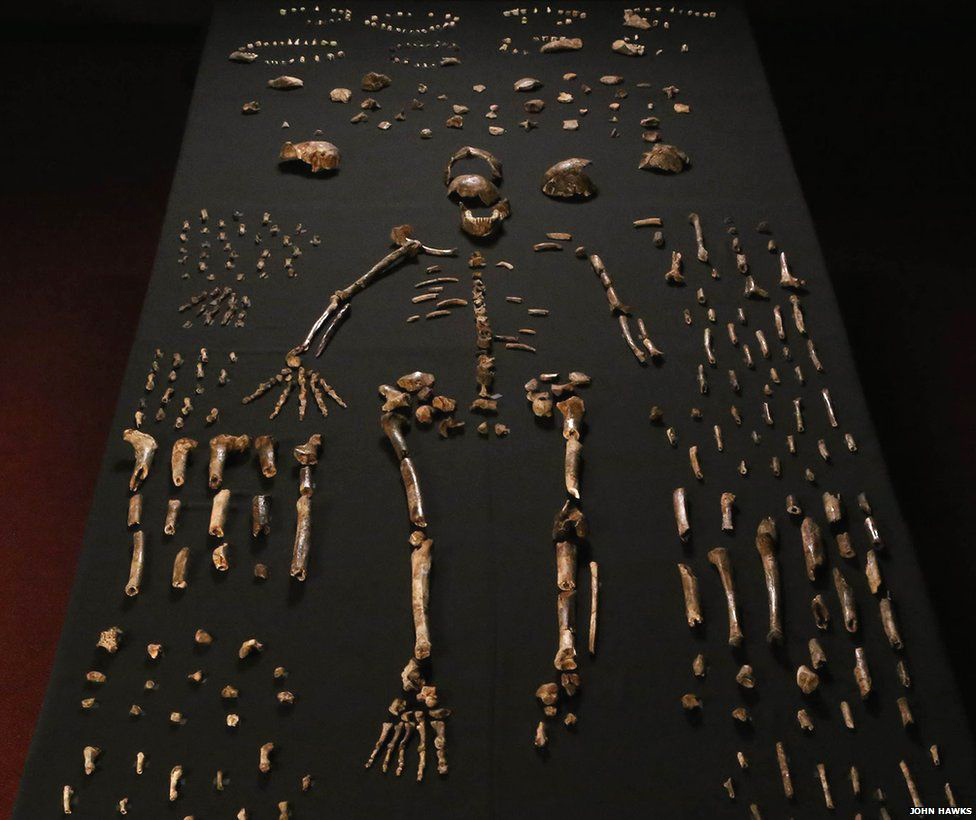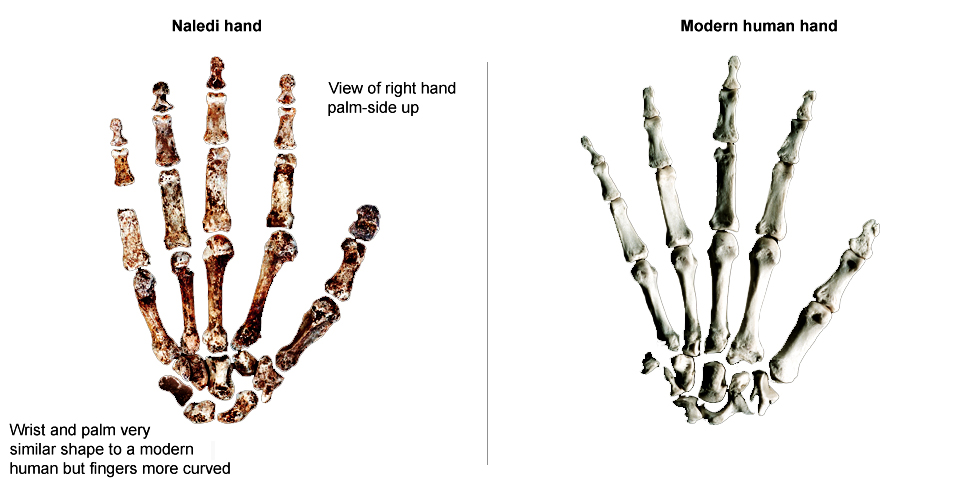


A BBC News article by Pallab Ghosh - New human-like species discovered in S Africa - reports on the discovery by scientists of a new human-like species in a burial chamber deep in a cave system in South Africa. The discovery, published in the journal Elife, of 15 partial skeletons is the largest single discovery of its type in Africa.

Homo naledi has a mixture of primitive and more modern features. Image: John Hawks
The species which has been named naledi has been classified in the grouping, or genus, Homo to which modern humans belong. The researchers claim that the discovery will change ideas about our human ancestors, partly because there is evidence that these individuals were capable of ritual behaviour.
The researchers as yet do not have a date for the species, but the team leader Professor Lee Berger believes they could be among the first of the genus Homo, living in Africa up to three million years ago, but emphasizes the term 'bridge' rather than 'missing link' regarding primitive bipedal primates and humans.
Professor Chris Stringer of the Natural History Museum adds that more and more discoveries suggests that nature was experimenting with how to evolve humans, thus giving rise to several different types of human-like creatures originating in parallel in different parts of Africa, yet only one line eventually survived to give rise to us.
The discovery includes a staggering 15 well preserved partial skeletons - both male and female, of varying ages ranging from infants to elderly. Infact, enough evidence of the species to indicate when its children were weaned, when they were born, how they developed, the speed at which they developed, the difference between males and females at every developmental stage from infancy, to childhood to teens to how they aged and how they died.
Homo naledi is unlike any primitive human found in Africa. It has a tiny brain - about the size of a gorilla's and a primitive pelvis and shoulders. But it is put into the same genus as humans because of the more progressive shape of its skull, relatively small teeth, characteristic long legs and modern-looking feet.

Image: Peter Schmid, SPL
How did the remains get to be in the Rising Star cave, in an area known as the Cradle of Humankind? The remains were found in a chamber, accessed only by a long narrow tunnel, which the researchers describe as a burial chamber. The Homo naledi people appear to have carried individuals deep into the cave system and deposited them in the chamber - possibly over generations.
If that is correct, it suggests naledi was capable of ritual behaviour and possibly symbolic thought - something that until now had only been associated with much later humans within the last 200,000 years.
In other words, what is unique to modern humans? Professor Berger asks if we inherited that behaviour from deep time, and is it something that the earliest humans have always been able to do. Does this redefine what it is to be human?
Visit the ORIGINS section for more information about the genus Homo:
http://www.bradshawfoundation.com/origins/index.php
Commentby Bradshaw Foundation
Tuesday 21 March 2023
by Bradshaw Foundation
Tuesday 07 February 2023
by Bradshaw Foundation
Thursday 19 May 2022
by Bradshaw Foundation
Tuesday 19 October 2021
by Bradshaw Foundation
Friday 25 June 2021
by Bradshaw Foundation
Monday 09 November 2020
by Bradshaw Foundation
Tuesday 03 November 2020
by Bradshaw Foundation
Wednesday 28 October 2020
by Bradshaw Foundation
Tuesday 23 June 2020
by Bradshaw Foundation
Thursday 04 June 2020
by Bradshaw Foundation
Thursday 14 May 2020
by Bradshaw Foundation
Tuesday 12 May 2020
by Bradshaw Foundation
Wednesday 19 February 2020
by Bradshaw Foundation
Tuesday 21 January 2020
by Bradshaw Foundation
Monday 20 January 2020
by Bradshaw Foundation
Thursday 28 November 2019
by Bradshaw Foundation
Tuesday 21 March 2023
by Bradshaw Foundation
Tuesday 07 February 2023
by Bradshaw Foundation
Thursday 19 May 2022
by Bradshaw Foundation
Tuesday 19 October 2021
by Bradshaw Foundation
Friday 25 June 2021
by Bradshaw Foundation
Monday 09 November 2020
by Bradshaw Foundation
Tuesday 03 November 2020
by Bradshaw Foundation
Wednesday 28 October 2020
by Bradshaw Foundation
Tuesday 23 June 2020
by Bradshaw Foundation
Thursday 04 June 2020
by Bradshaw Foundation
Thursday 14 May 2020
by Bradshaw Foundation
Tuesday 12 May 2020
by Bradshaw Foundation
Wednesday 19 February 2020
by Bradshaw Foundation
Tuesday 21 January 2020
by Bradshaw Foundation
Monday 20 January 2020
by Bradshaw Foundation
Thursday 28 November 2019
Friend of the Foundation











